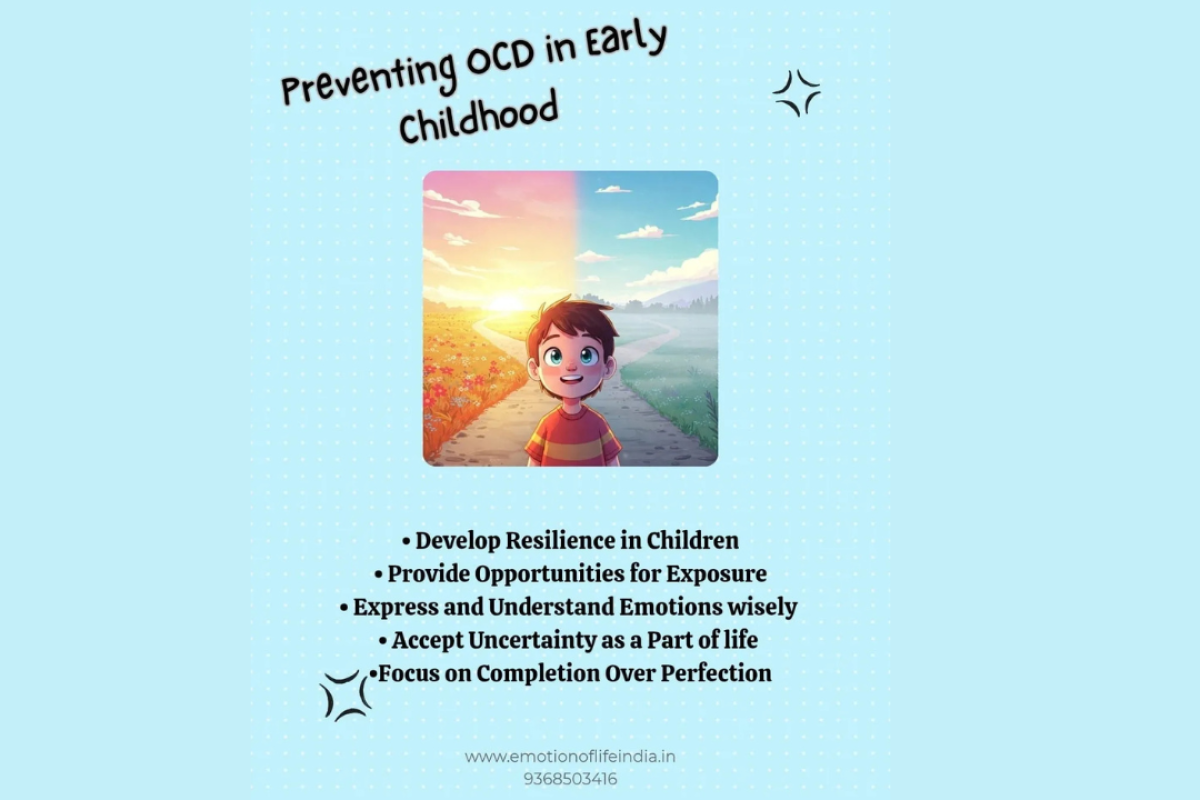Prevention of Childhood OCD
Obsessive-Compulsive Disorder (OCD) is a mental health condition that involves persistent, intrusive thoughts (obsessions) and repetitive behaviours (compulsions) performed to ease anxiety. These behaviours, although intended to reduce stress, often interfere with daily life. OCD can develop at any age, and early signs sometimes appear in childhood. Understanding and addressing these signs in the early years can prevent the condition from becoming more severe.
Prevention of Childhood OCD: What It Is and How It Manifests
Prevention of Childhood OCD, Childhood OCD often begins in early life, between the ages of 11 to 16, and is characterized by distressing, repetitive thoughts and compulsive actions that interfere with daily activities, school, and relationships. Unlike typical childhood habits, OCD behaviours are driven by intense anxiety and fear of consequences if rituals are not performed.
Symptoms of Childhood OCD
- Excessive handwashing, fear of dirt, or avoiding contact with surfaces
- Repeating actions, such as touching objects a certain number of times
- Needing things to be arranged in a specific order or symmetrical pattern
- Repeatedly seeking reassurance from parents or teachers
- Checking doors, schoolwork, or belongings excessively
- Avoiding certain places or activities due to irrational fears
- Intrusive and distressing thoughts about harm, mistakes, or negative consequences
Types of Childhood OCD
Prevention of Childhood OCD, OCD presents in various forms, and children may display symptoms differently. Common types include:
- Contamination OCD – Fear of germs, dirt, or illness.
- Checking OCD – Repeatedly checking locks, homework, or belongings.
- Symmetry and Order OCD – Need for things to be arranged perfectly.
- Harm OCD – Fear of causing harm to self or others.
- Intrusive Thoughts OCD – Unwanted and distressing thoughts.
- Counting and Repeating OCD – Compulsion to repeat or count actions.
- Hoarding OCD – Difficulty discarding items due to irrational fears.
Prevention of OCD in Childhood: Early Steps
Parents and caregivers can take proactive steps to reduce the risk of OCD and help children develop healthy coping mechanisms. Here are some strategies:
- Develop Resilience: Encourage problem-solving, stress management, and a supportive environment.
- Provide Opportunities for Exposure: Allow children to face fears gradually in a supportive way.
- Teach Emotional Independence: Help children differentiate constructive feedback from criticism.
- Strong Work Ethic: Engage them in meaningful activities to prevent rumination.
- Encourage Age-Appropriate Actions: Balance responsibility with natural growth pace.
- Celebrate Life and Embrace Experiences: Teach children that challenges are a natural part of life.
- Express and Understand Emotions Wisely: Open discussions about feelings prevent suppression.
- Encourage Action Over Excessive Thinking: Promote problem-solving through action.
- Handle Criticism in a Healthy Manner: Teach children to view criticism as an opportunity to grow.
- Accept Uncertainty: Model flexibility and tolerance for unpredictability.
- Focus on Completion Over Perfection: Encourage finishing tasks without stressing over perfection.
- Learn from Failure: Reframe failures as learning opportunities.
- Appreciate What You Have: Encourage gratitude and focus on strengths.
- Build Confidence Through Small Steps: Confidence grows through gradual achievements.
- Persistence Leads to Success: Encourage children to keep trying despite setbacks.
- Apply Knowledge in Constructive Ways: Help children use learning positively.
- Set Meaningful and Inspiring Goals: Motivate children with realistic yet exciting goals.
Success Stories of Overcoming Childhood OCD
Success Story 1
Aarav’s Early Intervention Prevention of Childhood OCD
Aarav, a 10-year-old boy, constantly washed his hands and feared contamination. His parents brought him to Emotion of Life early, where gentle ERP exercises and parental coaching helped him recover. Within 12 weeks, Aarav reduced his handwashing by 70% and regained confidence in school.
Success Story 2
Meera’s Journey Prevention of Childhood OCD
Meera, age 12, developed compulsions of checking her school bag repeatedly. With CBT, mindfulness, and family counseling at Emotion of Life, she overcame her compulsions in 4 months and regained focus on studies.
16 Steps of OCD Recovery & Cure Program at Emotion of Life for Prevention of Childhood OCD
- Comprehensive Assessment
- Personalized Recovery Roadmap
- Psychoeducation for Parents & Child
- Identifying Triggers
- Thought–Behavior Mapping
- Exposure & Response Prevention (ERP)
- Cognitive Restructuring (CBT)
- Mindfulness & Relaxation Skills
- Habit Reversal Training
- Parental Coaching
- Stress & Lifestyle Balance
- Emotional Resilience Training
- Progress Tracking
- Family Therapy Sessions
- Relapse Prevention Tools
- Celebrating Recovery
Conclusion on Prevention of Childhood OCD
Prevention of childhood OCD is about fostering resilience, emotional balance, and healthy coping mechanisms. With early identification, supportive parenting, and professional guidance, children can grow into emotionally strong individuals capable of handling life’s challenges without falling into obsessive or compulsive patterns.









